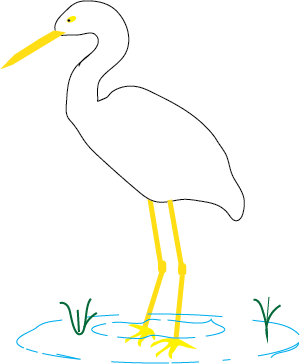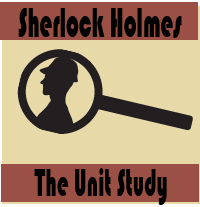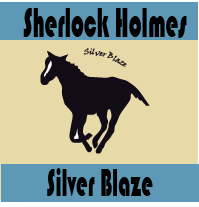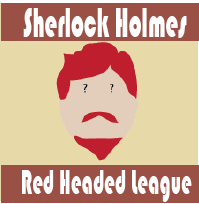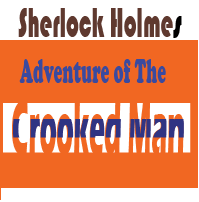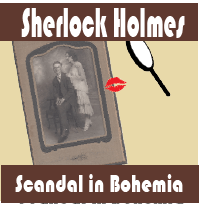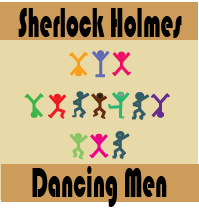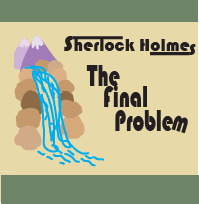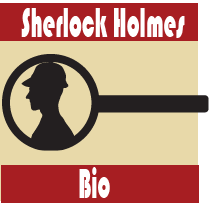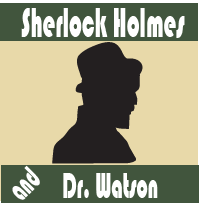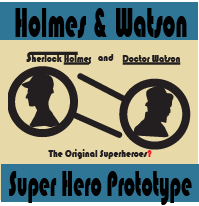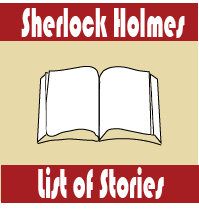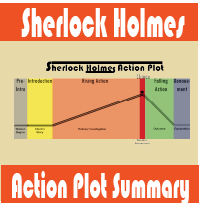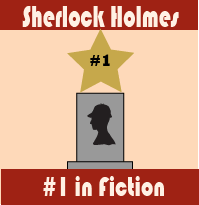Sherlock Holmes Summary
Our summary of Doyle's Action Plot helps students and fans analyze the stories.

Plot Structure
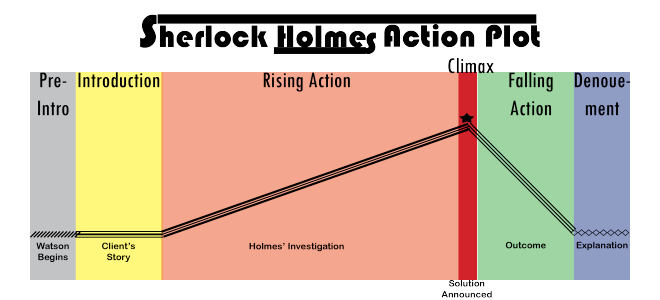
But here is Doyle's trick. His introductions to each story include a pre-introduction. Doyle's Pre-Introductions changed everything and inducted his character into literature's hall of fame.
Before we describe how the pre-introduction is so brilliant, let's do a quick summary of the action plot:
- Pre-introduction - Watson describes Holmes and his practice
- Introduction - A client presents the details of the case
- Rising Action - Holmes investigates
- Climax - The solution of the mystery is presented
- Falling Action - We find out what happens to the client, the criminals, and anyone else
- Denouement - Holmes fills in the details Watson and the readers missed.
- Introduction through Denouement: 56 self-contained tales that can stand alone as a short story
- Pre-Introduction: The outer frame that connects the short stories but tells a different story

Function of the Pre-Introduction
This was an intentional device used by Doyle and it served him and his fictitious characters well. It also increased sales and circulation for The Strand magazine as readers eagerly waited for the next story.But it did more than that.
The short stories themselves best fit the description of popular literature. Yes, they were popular. But they didn't quite rise to the level of classic literature.
Now - add those short pre-introductions and something almost magical occurs. Sherlock moves from popular literature to classic literature.
The pre-introductions tell of the career and friendship that span three decades of a quirky, somewhat-narcisstic genius detective and the humble, helpful assistant who made him almost human.
If you took out the pre-introductions from the stories and changed the names so Sherlock and Watson weren't mentioned, you would still have 56 good detective stories. But when you add the human story of the anti-social Sherlock and the warm-hearted Watson you up the ante.
A century after the original publication, fans are still searching for insights into these two individuals and the tension/friendship between them. Now THAT is classic literature!
Detailed Summary of Sherlock Holmes Stories
Look at the parts of the action plot in more detail. Writing a paper on one or more stories? You can show how Doyle altered the details of one particular story from the general plot template he used.- Pre-Introduction: Three Types
There are generally three types of Pre-Introductions. The first (and most fun) is comprised of a little drama between Sherlock and Watson prior to the arrival of the client. The second is a contemplation on the part of Watson of why he should chose which case to publish. And the real humdingers are his one-line dramatic declarations.
- Introduction: The Problem
Here we get into the gist of the action. The client arrives on the scene and narrates the problem for Sherlock to solve. Most of the time this occurs in his sitting room at 221B Baker St. Usually Watson is present. And most of the time the client is a victim of a crime that has been committed or will be committed. Watch for variations in this, as they add variety to the style.
- Rising Action: The Hunt
The rising action occurs as Holmes begins to track down the culprit and solve the mystery. Usually this involves traveling to the site of crime - but again there is a lot of variety in how he proceeds. Sometimes imminent danger is present. Often Watson accompanies him, sometimes he travels alone and reports back, and occasionally he even sends Watson out alone.
In general, Watson is watching him and wondering what Holmes is doing and thinking.
- The Climax: The Catch
The climax occurs as Holmes clasps the hand-cuffs on the surprised villain, or announces the victim is actually the perpetrator, or in any other fashion declares the solution of the mystery to the astonishment of Watson, the reader, and the Scotland Yard detectives.
- Falling Action: Solution explained
The favorite part of the stories is when the omniscient Sherlock explains his deductive reasoning to the ever-patient and humble Watson.
- Denouement: Outcomes for All
Usually it is a good outcome, thanks to Holme's genius. But thanks to Doyle's genius we can search for variety here as well. Outcomes might be shared elsewhere in the plot. But Sherlock can always use the denouement to clear up any final matters we might have missed. AND don't forget to look for his (usually) snarky final statement.

Sherlock Holmes Projects
Writing Ideas for Sherlock Holmes Reports
1. Read three different short stories. Notice the differences in the plot formation (see Summary above.) Write an analysis of how they are the same or different.2. Develop this thesis statement: The characters of Sherlock Holmes and/or Dr. Watson actually represent Arthur Conan Doyle himself.
3. Point of View: The Sherlock Holmes tales are excellent examples of the first person point of view. 54 of the short stories and all 4 longer mysteries were supposedly written by Watson. This is a prominent example of the narrator not being the main character. What is the literary value of the character, Watson? How would the stories have been different if they were written by Sherlock?
4. Use one of the Sherlock Holmes Quotes and develop your paper around it. Tell how this quote describes the detective and his work in a particular short story.
5. Try to write a detective story yourself. First, imagine the crime and reason for it. Second, develop the crime scene that is left at the end. Three, little by little have the clues found and the mystery solved. It maybe a little trickier than you think!
6. Sherlock Holmes stories take place in Victorian England. So did Charles Dickens stories. Write a short narrative of two characters meeting. Perhaps Sherlock could solve a mystery for old Scrooge himself.
7. Do a character anaylsis of Sherlock. Read a few stories, list the character qualities you discern, and develop a description and example of each. Here is an example of how to do a character sketch.
Finally, our Sherlock Holmes Unit Study will lead you through an indepth analysis of eight of the most popular stories. It includes background information, comprehension questions, hands-on activities, vocabulary words, and more.
Buy Sherlock Holmes: The Unit Study
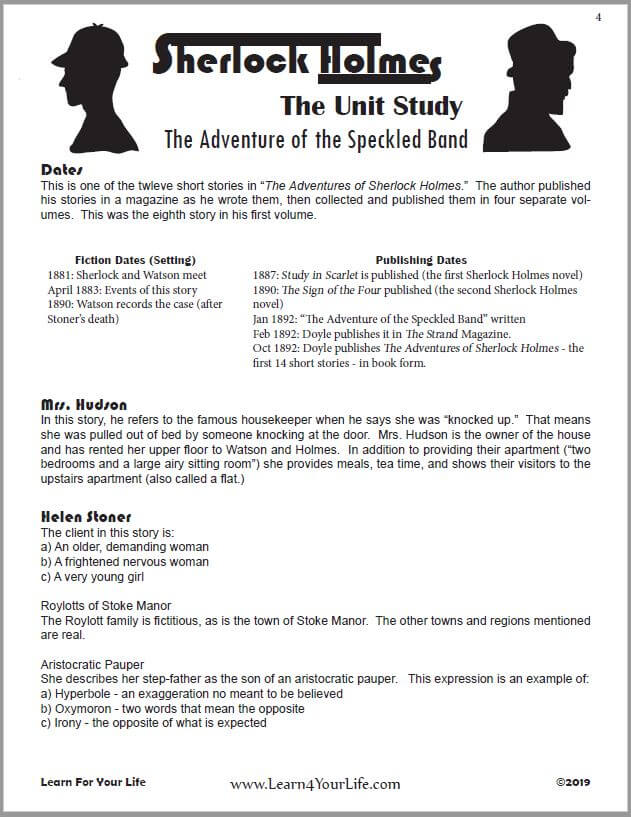
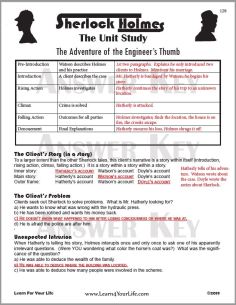
Student Guide AND Teacher's Answer Key Included
$2.99 Download - 183 pages
Eight of the most popular tales demonstrate how to investigate a detective story.
![]()
Sherlock Holmes Pages
A catalog of our pages on Sherlock Holmes.

